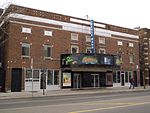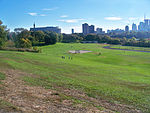Playter Estates
AC with 0 elementsNeighbourhoods in Toronto

Playter Estates is an area in the east end of Toronto, Ontario, Canada bounded by Jackman Avenue to the east, the Don River Valley to the west, Danforth Avenue in the south, and Fulton Avenue in the north. The neighbourhood is built on land once owned by the Playter family for whom two streets in the area are named. The old farmhouse of the Playter household at 28 Playter Crescent is now the Playter Mansion, which is often used for various films, television shows, and commercials.
Excerpt from the Wikipedia article Playter Estates (License: CC BY-SA 3.0, Authors, Images).Playter Estates
Playter Boulevard, Toronto
Geographical coordinates (GPS) Address Nearby Places Show on map
Geographical coordinates (GPS)
| Latitude | Longitude |
|---|---|
| N 43.678055555556 ° | E -79.355555555556 ° |
Address
Playter Boulevard 12
M4K 1N6 Toronto
Ontario, Canada
Open on Google Maps









